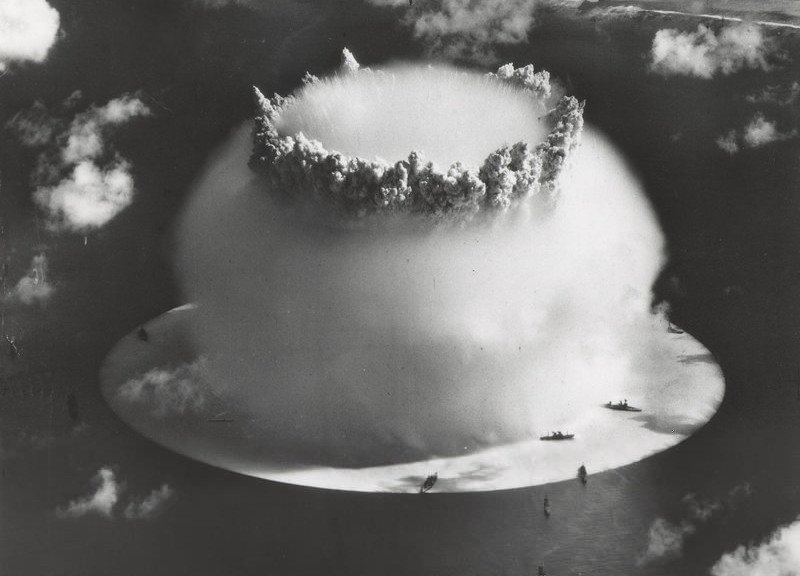“…NOW I AM BECOME DEATH…THE DESTROYER OF WORLDS:” HOW WE BUILT THE BOMB
HOW WE BUILT THE BOMB
on Discovery Channel

Pros: Accessible, captivating, and informative, with a wealth of astounding archival footage
Cons: Actual interviews not included
Made for the Discovery Channel networks and first broadcast in mid 2015 to mark the seventieth anniversary of the Trinity Test, How We Built the Bomb takes the form of a dramatized documentary that tells the story of the American atomic program from start to finish. The program (two hours with commercials) begins with the now-famous letter written by Albert Einstein warning American president Franklin Roosevelt that Nazi Germany may in fact be working on a “superbomb” that would be powered not by conventional explosives, but by splitting the atom. As America enters World War II in the coming years, a priority is placed on unlocking the secrets of nuclear fission and developing a uranium or plutonium based explosive device (referred to by scientists as “the gadget”) before the Germans did. This involved a large and incredibly secretive operation across several states, with the main research and development facility located in a remote section of the New Mexican desert.
Some of the many personnel involved in the Manhattan Project whose viewpoints are told in the documentary through re-imagined interviews.
Lacking a traditional narration, How We Built the Bomb (written by David Broodell) is told from the perspective of the people who worked on the so-called “Manhattan Project,” but instead of using actual archival interviews, the production is based around an extended series of recreated interviews with actors portraying the various scientists, military and support personnel, and others who found themselves involved in some way with this tremendous undertaking. At first, this approach seems awkward and maybe even reprehensible since the ongoing dialogue is fictionalized to an arguably large extent. As the program wore on however, I grew more and more absorbed in the unfolding story being told and found the format of the documentary to be less detrimental than I would have originally thought.
Despite the government’s best efforts, security among project personnel was compromised on several occasions.
Along with these dramatized interviews, the program also presents a rather large amount of home movies and film footage taken by residents of Los Alamos, New Mexico (for all intents and purposes, the center of the R&D division of the Manhattan Project) during this era. When combined with the speakers, this footage goes a long way in not only telling a detailed history of the nuclear program, but also explaining what life was like for the scientists, spouses, military personnel and support staff who found themselves working on an underground project in a top secret location. Much of the program (rightfully) focuses on efforts to come to grips with the physics behind fission and put such theories into practice, but How We Built the Bomb also includes some rather humorous observations about the ways in which project personnel unwound after long hours in the lab. I found myself chuckling at explanations of what went into the highly alcoholic “tech area punch” that scientists consumed during their off hours and was similarly amused by one military man’s frustration at the fact that some eighty babies were born at the facility in 1944, indicating another method of stress relief practiced by the town’s residents.
Site of the Trinity Test, viewed after the first detonation in July, 1945.
Unsurprisingly, the documentary starts to ratchet up the tension level down the stretch when scientific theory doesn’t quite match up with actual experimental results and it becomes apparent that a new method of detonation must be sought. By this point in 1944, though the war in Europe is nearing its conclusion, a long, drawn-out and very costly invasion of Japan is imminent unless the bomb can be used to precipitate a quick end to the conflict. Accompanied by almost psychedelic music cues, the segment dealing with the initial Trinity Test, the world’s first detonation of an atomic weapon, is very deliberate in its construction which maximizes the impact of the event on a viewer. I should also state that while the program does chronicle the period up to and including the unconditional surrender of the Japanese following the bombings of Hiroshima and Nagasaki, these events are only briefly touched on; the documentary is clearly more focused on the actual development of the atom bomb, not its deployment.
One of the strongest aspects of the documentary is the way in which it breaks down complicated physics in a way that can be understood by viewers who in all likelihood don’t have encyclopedic knowledge of the processes involved. Even if the interview subjects do on occasion go into lengthy and extremely complicated explanations of the mathematics involved in solving the problems of nuclear fission, they subsequently reveal what they were trying to accomplish in “layman’s terms.” An offscreen “interviewer” character (who a viewer is never truly introduced to) acts as the voice of the viewer at times, prompting the speakers to answer questions in a more straight-forward manner. Visuals and graphics that accompany these segments also aid in a viewer’s understanding of the concepts being discussed: I got a kick out of the now almost humorous vintage educational film footage utilized during certain segments, and nifty special effects attempt to visualize what actually happens when fission starts to take place in a nuclear device.
It’s kind of scary that none of the scientists working on the project quite knew what would happen when an atomic detonation occurred – some feared that the blast would actually ignite the atmosphere.
In my opinion, one of the most interesting aspects of the nuclear program was the fact that the scientists involved in making the atom bomb faced serious moral dilemmas. Truly, at the time it was only these scientists who fully comprehended what effect these weapons would have should they be used against enemy forces – or civilians – and many were vehemently opposed to the military deployment of “the gadget.” How We Built the Bomb deals with this issue about as well as one would expect or hope for in a program of this nature, prompting the viewer to question whether the Hiroshima and Nagasaki bombings were genuinely necessary. It’s worth noting that it was Harry Truman, who assumed the Presidency of the United States after the death of FDR and only found out about the Manhattan Project after he had been sworn in, that actually authorized these attacks. One has to wonder if he was aware of what the consequences of this action would be, and in a modern society that’s gotten all-too-used to the idea of nuclear threat, it’s worth remembering that the United States is still the only nation that has ever used an atomic device against other human beings.
When viewing this program, one is left with a sense of awe – not only with the power of the atomic bomb itself, a power which is hammered home time and again throughout the film, but with the fact that such a seemingly impossible scientific undertaking as to make such a device was accomplished in a short time under rather adverse conditions. No matter what one’s feelings are about nuclear weapons, it’s pretty amazing that scientists were able not only to understand how the fission process worked but also how it can be harnessed and (at least partially) controlled. Edited in a very capable manner with a quietly effective music score provided by Brendan Anderegg, How We Built the Bomb ultimately celebrates the tremendous scientific achievement that the bomb was the end result of. Although to an extent it makes the scientists involved out to be heroic figures, to its credit the program doesn’t necessarily present the bombing of Japan as a moment of triumph or jubilation, ending instead on a somber and even ominous note, with various blurbs from political speeches and news broadcasts reminding the viewer how fundamentally the world was changed with the advent of the bomb. I think that’s about as appropriate an end statement that could be made, and would whole-heartedly recommend this documentary to any interested viewer.
from on .
















